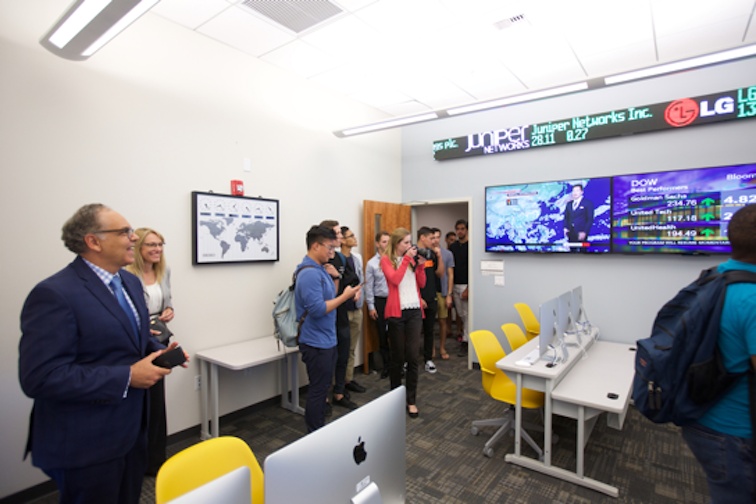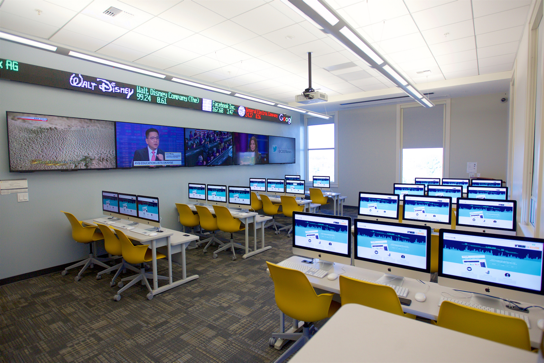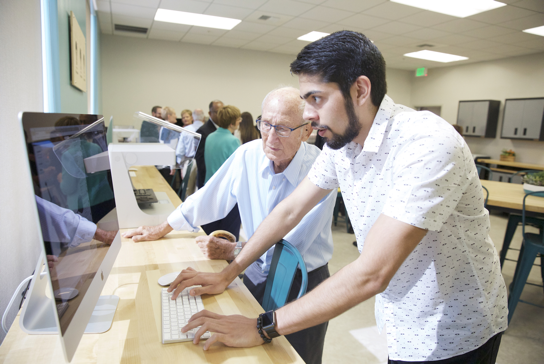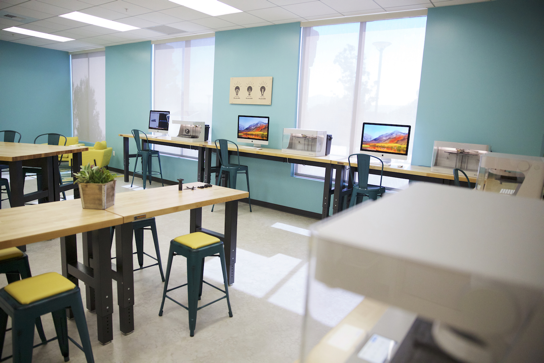La Sierra University’s Zapara School of Business is helping students engage in real-world financial decision-making and entrepreneurship with two high-tech labs which opened this fall.
The Finance Lab, which utilizes StockTrak stock market simulation software, and the Innovation Lab, which offers industry-grade MarkForged 3D printers, are designed to influence individual thinking, analysis, and creativity with faculty serving as guides and resources for students as they forge career paths and build businesses.


La Sierra University Vice President of Financial Administration David Geriguis, left, and Associate Vice President of Financial Administration Pamela Chrispens smile as they view the new Finance Lab at La Sierra’s Zapara School of Business. They cut the ribbon inaugurating its opening on Sept. 27. (All photos: Natan Vigna)
The Finance Lab, and its accompanying Investor Club, was conceived and developed over the summer. StockTrak is a state-of-the-art leading provider of virtual trading applications for universities, corporations, and the public. Over 1,000 professors in 30 counties and their 60,000 students use the stock market educational simulation and real-time trading platform. Students are able to participate in financial management and investing activities including trading stocks, options, futures, bonds, and mutual funds from more than 50 global exchanges.
The lab’s ZSB Investor Club, open to La Sierra students, employees, and alumni, will manage the growth of a $100,000 portfolio for the business school, with the potential of increasing the porfolio investment to $250,000 in the future. The portfolio is seeded with funds from donors and is supervised by the university’s controller and two business school faculty with expertise in finance. The club’s annual report, submitted to business school Dean John Thomas, will be audited and made publicly available online.
Club leaders and more experienced members will be able to make trading decisions for the club portfolio by viewing the financials of publicly-traded companies, analyzing risk profiles and macroeconomic assessments of the economy, among other activities. Club members will learn trading strategies for their own education and independent trading activities with their own portfolios. Students and La Sierra community members who want to use the StockTrak system must become members of the Investment Club and attend all club sessions and seminars. Neither the Investment Club nor any of its members or leadership representatives will provide any direct stock trading advice to anyone.
“The Finance Lab provides students with a great hands-on experience of how capital markets function,” said Vice President of Financial Administration David Geriguis. “Students’ classroom work combined with the resources available in this lab exposes them to the contagious excitement of research, thorough analysis, risk-taking, and wealth creation. It is absolutely fascinating. Even faculty and staff may benefit from educational opportunities offered in this lab as they think about retirement investment strategies.”
The Innovation Lab is outfitted with tall, industrial-style tables and stools in the middle of the lab, with 3D printers and iMac computers situated on counters around the room’s perimeter. The lab provides four MarkForged Onyx 3D prototype printers and one MarkTwo 3D printer which is capable of printing industrial-grade parts with high temperature fiberglass as well as kevlar, regular fiberglass, and carbon fiber. The system comes with Markforged browser-based 3D printing software, Eiger, which allows easy project collaboration. These top-tier industrial grade printers can make any sort of 3D prototype part and are cloud-managed. They are used by such powerhouse organizations as Google, Amazon, Ford, NASA, and the U.S. Air Force.


Zapara School of Business student and Troesh Team Coordinator Jonathan Thomas, right, shows
Tom Zapara how a 3D printing system works during the Innovation Lab’s grand opening. The business
school is named for Tom and his wife, Vi Zapara.
Included in the lab are five iMac computers providing industry-standard creative cloud software, and a large format commercial printer for marketing students.
The lab functions as a “maker space” where students, staff, and faculty can collaborate on new ideas, said Thomas.
He noted that the opportunity facing entrepreneurs today is being able to take a product to market within 30 days. “Can we challenge our students to come up with ideas that we can take to market? We want to provide the environment for students to think, to challenge themselves, be innovative, be creative, get excited about their discipline, and change the world,” Thomas said.
The two labs are emblematic of a growing trend in higher education to create a practical and dynamic learning experience in which the professor functions more as a source of support and expertise rather than as a solo act at the front of the classroom, said Thomas. “Experiential learning is the next big thing,” he said. “One of the criticisms in the marketplace of traditional education is that it is mainly theoretical. These new labs help bridge that gap between practical, applicable experience and theoretical knowledge and bring our students inside the business and entrepreneurial worlds to become creators and decision-makers.”
About La Sierra University
La Sierra University, a Seventh-day Adventist institution nationally acclaimed for its diverse campus and its service to others, offers a transformational experience that lasts a lifetime.
U.S. News & World Report for six years named La Sierra University the most racially diverse university in the western United States. In addition, in September 2016 and 2017, the Wall Street Journal/Times Higher Education top colleges ranking named La Sierra University the most diverse campus in the nation. Additionally, U.S. News and World Report’s 2017 Best Colleges guide listed La Sierra ninth in the 15-state western region for best value. This follows the July 2015 Money magazine list which ranked La Sierra University eighth in the nation for providing value-added education that helps students surpass expectations. Each year, from 2008 to 2014, the Corporation for National and Community Service included La Sierra in the President’s Higher Education Community Service Honor Roll awards. These awards include La Sierra’s receipt of the prestigious 2013 Presidential Award, the highest honor a college or university can receive for its commitment to volunteering, service-learning, and civic engagement. The corporation’s awards recognize La Sierra’s students for providing thousands of hours of service including international economic development projects by La Sierra’s world cup-winning Enactus team, and community projects through La Sierra’s campus-wide, Service-Learning program.
In December 2008, the Carnegie Foundation for the Advancement of Teaching included La Sierra on its 2008 Community Engagement Classification lists consisting of 119 colleges and universities around the United States. La Sierra University achieved re-classification status in 2015.
The Seventh-day Adventist denomination established La Sierra University in 1922 on acreage formerly part of the Rancho La Sierra Mexican land grant. Today the 150-acre campus provides more than 120 bachelors, masters, and doctoral degrees for about 2,300 students. Programs are offered in the Tom and Vi Zapara School of Business, the School of Education, the H.M.S. Richards Divinity School, the College of Arts and Sciences, and in the Evening Adult Degree Program.
“To Seek, To Know, and To Serve” is the key to the mission that drives La Sierra University, with all areas of campus encouraging students to develop a deeper relationship with God.
